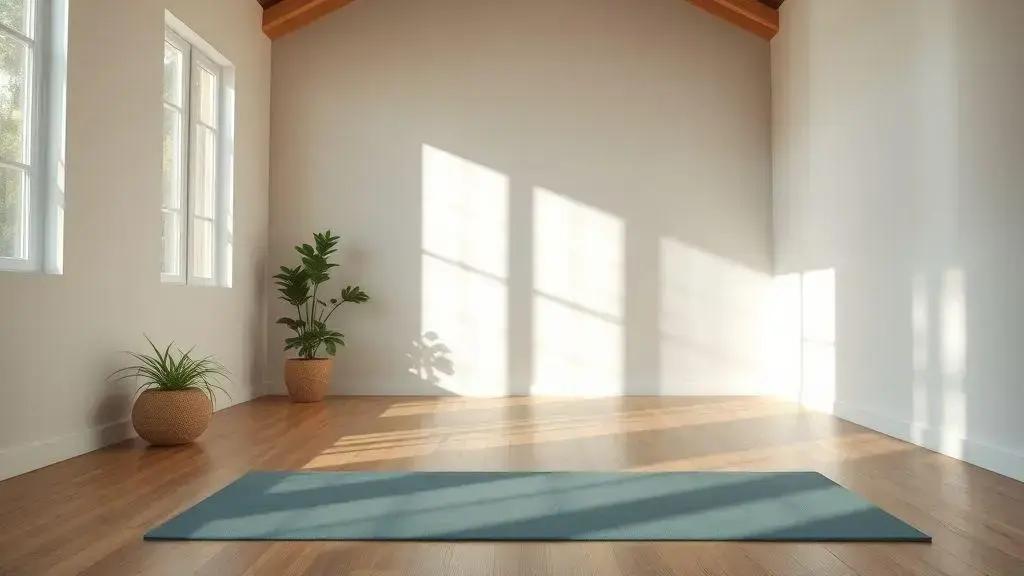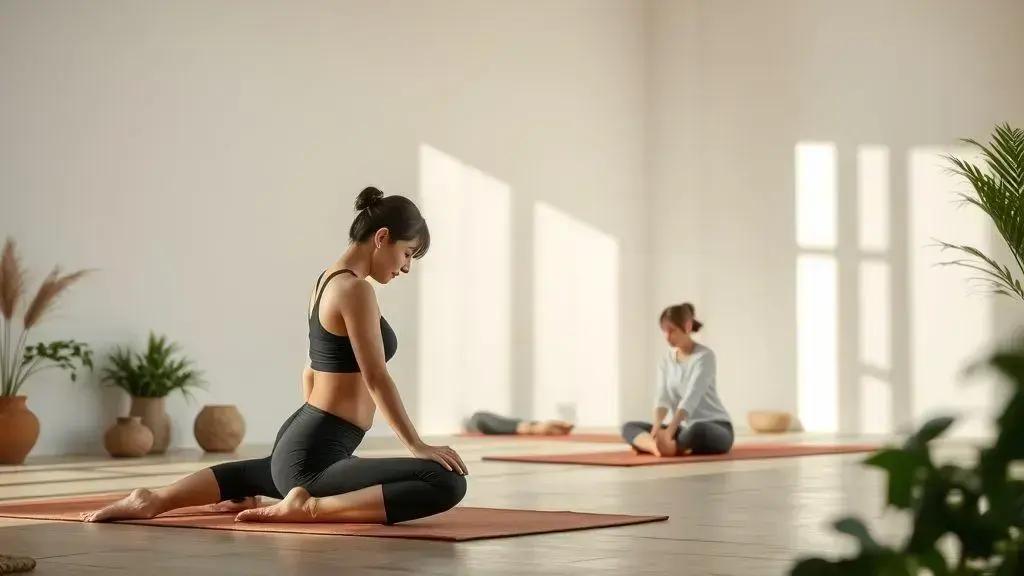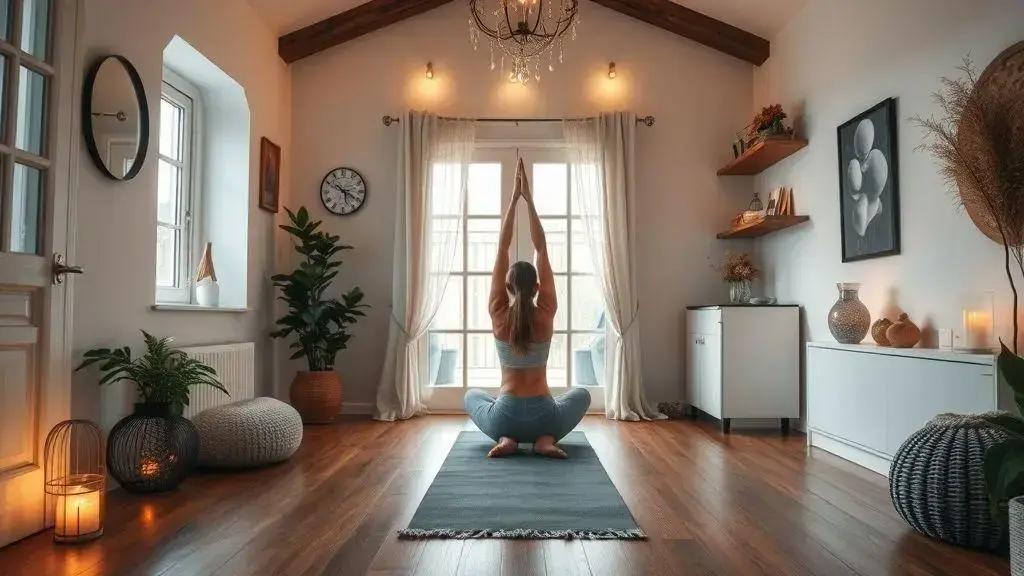Yoga sequences designed for relaxation and recovery

Yoga sequences designed for relaxation and recovery effectively reduce stress, improve flexibility, and promote mental calmness, making them ideal for enhancing overall well-being.
Yoga sequences designed for relaxation and recovery can significantly enhance your daily wellness. Ever wondered how simple poses can create a profound impact on your mind and body? Let’s explore the art of relaxation through yoga.
Understanding the benefits of yoga for relaxation
Understanding the benefits of yoga for relaxation is essential for anyone looking to enhance their well-being. Through mindful movements and deep breathing, yoga helps to release tension and promote a sense of calm. It’s more than just exercise; it’s a holistic approach to improving mental and physical health.
Calming the Mind
One significant benefit of yoga is its ability to calm the mind. Practicing yoga can help alleviate stress and anxiety. As you engage in focused breathing and gentle stretches, you become more aware of your thoughts and feelings.
Physical Benefits
Yoga also provides numerous physical benefits that contribute to relaxation.
- Increases flexibility and mobility.
- Improves circulation and blood flow.
- Reduces muscle tension and pain.
- Enhances overall physical well-being.
Through regular practice, individuals often experience less discomfort in their bodies, which naturally leads to a more relaxed state.
Promoting Better Sleep
Many people find that yoga promotes better sleep. The calming techniques learned in yoga can help prepare both the body and mind for rest. By reducing stress levels and calming the nervous system, yoga sets the stage for a peaceful night’s sleep.
Finding a suitable yoga routine may require some exploration. Some prefer restorative poses, while others may enjoy a gentle flow. Regardless of your preference, the key is to choose practices that resonate with you and encourage relaxation.
Incorporating yoga into your daily life can lead to lasting benefits. It helps you cultivate a more peaceful mindset while developing a deeper connection with your body. By understanding the benefits of yoga for relaxation, you take an important step towards enhancing your overall quality of life.
Key yoga poses for recovery

Key yoga poses for recovery are essential for anyone aiming to restore balance and flexibility in their body. Incorporating these poses into your routine can significantly enhance your recovery process after workouts or stressful days.
Forward Fold
The Forward Fold pose is excellent for stretching the hamstrings and calming the mind. As you bend forward, allow the head to hang heavy, inviting relaxation.
Child’s Pose
This gentle pose offers a deep stretch for the back and hips. It creates a sense of safety and restoration, making it a favorite for many yogis.
- Supports relaxation and stress relief.
- Stretches the spine, hips, and legs.
- Encourages mindful breathing.
- Can be practiced any time for quick relief.
Practicing Child’s Pose can help rejuvenate your energy throughout the day.
Reclining Bound Angle Pose
This restorative pose opens the hips and promotes relaxation. As you rest in this position, focus on your breath and allow your body to release tension.
Incorporating these key yoga poses into your practice can enhance your overall recovery experience. They help your body heal while also soothing your mind. Remember, listening to your body is crucial; modify poses as needed to suit your comfort level. Consistency in practice can lead to long-term benefits, fostering a sense of peace and well-being.
How to create a relaxing yoga sequence
Creating a relaxing yoga sequence can transform your practice into a soothing experience. With the right poses and mindful transitions, you can build a routine that calms the mind and body. It’s essential to focus on your breath and let each pose flow into the next.
Starting with Breath Awareness
Begin your sequence by finding a comfortable seated position. Take a few deep breaths, inhaling through the nose and exhaling through the mouth. Notice how your body feels as you settle into the moment.
Choosing the Right Poses
Select poses that promote relaxation and release tension. Here are some poses to consider:
- Cat-Cow Stretch: This pose warms up the spine and helps relieve back tension.
- Legs-Up-the-Wall: This restorative pose improves circulation and calms the nervous system.
- Seated Forward Bend: A gentle stretch that soothes the lower back and hamstrings.
- Corpse Pose: End your sequence in this pose for final relaxation and reflection.
As you flow through these poses, focus on maintaining a steady breath. Allow each inhale to fill your body with calm and each exhale to release tension. Transition smoothly from one pose to the next, letting go of any rush or urgency.
Incorporating Mindfulness
Mindfulness is crucial in a relaxing sequence. Pay attention to how your body responds to each pose. If you feel discomfort, adjust your position or take a moment in a restful pose. This practice is about finding peace and comfort in your body.
Creating a relaxing yoga sequence is an act of self-care. It allows you to take a break from the chaos of daily life and reconnect with yourself. Use your practice to create calmness, and don’t forget to enjoy the journey of relaxation.
Tips for incorporating yoga into your routine

Incorporating yoga into your routine can greatly enhance your physical and mental well-being. It’s about finding small ways to make yoga a consistent part of your daily life. Here are some practical tips to help you get started.
Set a Specific Time
Designating a specific time each day to practice yoga can help create a habit. Whether it’s morning, noon, or evening, choose a time that fits your schedule. This commitment will allow you to look forward to your practice.
Create a Dedicated Space
Having a designated space for yoga at home can enhance your practice. Make it inviting with soft lighting, cushions, or plants. A peaceful environment encourages relaxation and mindfulness.
- Choose a quiet area where you won’t be interrupted.
- Keep your yoga mat and props easily accessible.
- Decorate your space with calming colors or inspirational quotes.
- Play soothing music or nature sounds to enhance your experience.
Establishing a personal sanctuary will help signal your body that it’s time for yoga.
Start with Short Sessions
When starting, short sessions can be more manageable. Aim for 10 to 15 minutes each day and gradually increase the time as you become more comfortable. Focusing on quality over quantity is key.
Listen to your body and choose poses that feel good. Integrating yoga into your routine should bring joy, not stress. Consider using guided videos or classes to help structure your practice.
Yoga offers numerous benefits for relaxation and recovery, making it an ideal practice for anyone looking to enhance their well-being. By incorporating key poses into your routine and being mindful of your breath, you can cultivate a calming environment. Remember to set aside dedicated time for practice and create a space that inspires tranquility. With patience and consistency, you’ll find that yoga not only relaxes your body but also soothes your mind, leading to a more balanced life.
FAQ – Frequently Asked Questions about Yoga for Relaxation and Recovery
What are the benefits of yoga for relaxation?
Yoga helps reduce stress, improves flexibility, and promotes a sense of calm, which aids in relaxation.
How often should I practice yoga for relaxation?
It’s beneficial to practice yoga 3 to 5 times a week, even if for short sessions of 10-15 minutes.
What are some beginner-friendly poses for relaxation?
Child’s Pose, Forward Fold, and Legs-Up-the-Wall are great poses for beginners focusing on relaxation.
Can yoga help with sleep issues?
Yes, practicing yoga regularly can improve sleep quality by reducing stress and promoting relaxation.





